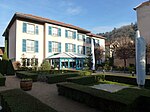Sainte-Colombe, Rhône
Communes of Rhône (department)Pages including recorded pronunciationsPages with French IPARhône (department) geography stubs

Sainte-Colombe (French pronunciation: [sɛ̃t kɔlɔ̃b] ; Arpitan: Sente-Colomba), sometimes referred to as Sainte-Colombe-lès-Vienne, is a commune in the Rhône department in eastern France. Occupied since Roman times, it is across the Rhône river from Vienne.
Excerpt from the Wikipedia article Sainte-Colombe, Rhône (License: CC BY-SA 3.0, Authors, Images).Sainte-Colombe, Rhône
Rue du Salin, Lyon
Geographical coordinates (GPS) Address Nearby Places Show on map
Geographical coordinates (GPS)
| Latitude | Longitude |
|---|---|
| N 45.5261 ° | E 4.8675 ° |
Address
Rue du Salin 36
69560 Lyon
Auvergne-Rhône-Alpes, France
Open on Google Maps






